Related Research Articles

Screen printing is a printing technique where a mesh is used to transfer ink onto a substrate, except in areas made impermeable to the ink by a blocking stencil. A blade or squeegee is moved across the screen to fill the open mesh apertures with ink, and a reverse stroke then causes the screen to touch the substrate momentarily along a line of contact. This causes the ink to wet the substrate and be pulled out of the mesh apertures as the screen springs back after the blade has passed. One colour is printed at a time, so several screens can be used to produce a multi-coloured image or design.
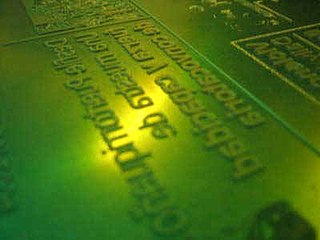
Flexography is a form of printing process which utilizes a flexible relief plate. It is essentially a modern version of letterpress, evolved with high speed rotary functionality, which can be used for printing on almost any type of substrate, including plastic, metallic films, cellophane, and paper. It is widely used for printing on the non-porous substrates required for various types of food packaging.

BoPET is a polyester film made from stretched polyethylene terephthalate (PET) and is used for its high tensile strength, chemical and dimensional stability, transparency, reflectivity, gas and aroma barrier properties, and electrical insulation.
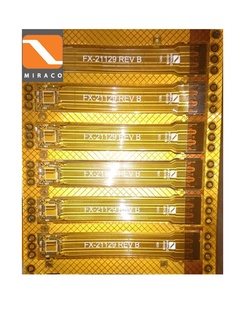
Flexible electronics, also known as flex circuits, is a technology for assembling electronic circuits by mounting electronic devices on flexible plastic substrates, such as polyimide, PEEK or transparent conductive polyester film. Additionally, flex circuits can be screen printed silver circuits on polyester. Flexible electronic assemblies may be manufactured using identical components used for rigid printed circuit boards, allowing the board to conform to a desired shape, or to flex during its use.
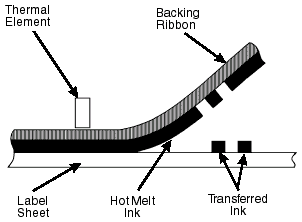
Thermal-transfer printing is a digital printing method in which material is applied to paper by melting a coating of ribbon so that it stays glued to the material on which the print is applied. It contrasts with direct thermal printing, where no ribbon is present in the process.

Lamination is the technique/process of manufacturing a material in multiple layers, so that the composite material achieves improved strength, stability, sound insulation, appearance, or other properties from the use of the differing materials, such as plastic. A laminate is a permanently assembled object created using heat, pressure, welding, or adhesives. Various coating machines, machine presses and calendering equipment are used.

Thermal printing is a digital printing process which produces a printed image by passing paper with a thermochromic coating, commonly known as thermal paper, over a print head consisting of tiny electrically heated elements. The coating turns black in the areas where it is heated, producing an image.
A pouch laminator uses a lamination pouch that is usually sealed on one side. The inside of the lamination pouch is coated with a heat-activated film that adheres to the product being laminated as it runs through the laminator. The substrate side of the board contains a heat-activated adhesive that bonds the print to the substrate. This can be any of a number of board products or another sheet of laminate. The pouch containing the print, laminate, and substrate is passed through a set of heated rollers under pressure, ensuring that all adhesive layers bond to one another.
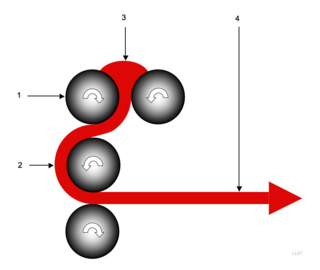
A calender is a series of hard pressure rollers used to finish or smooth a sheet of material such as paper, textiles, or plastics. Calender rolls are also used to form some types of plastic films and to apply coatings. Some calender rolls are heated or cooled as needed. Calenders are sometimes misspelled calendars.

A label is a piece of paper, plastic film, cloth, metal, or other material affixed to a container or product, on which is written or printed information or symbols about the product or item. Information printed directly on a container or article can also be considered labelling.
A coating is a covering that is applied to the surface of an object, usually referred to as the substrate. The purpose of applying the coating may be decorative, functional, or both.
A platen is a flat platform with a variety of roles in printing or manufacturing. It can be a flat metal plate pressed against a medium to cause an impression in letterpress printing. Platen may also refer to a typewriter roller which friction-feeds paper into position below the typebars or print head. It can refer to the glass surface of a copier, and the rotating disk used to polish semiconductor wafers.

Hot-melt adhesive (HMA), also known as hot glue, is a form of thermoplastic adhesive that is commonly sold as solid cylindrical sticks of various diameters designed to be applied using a hot glue gun. The gun uses a continuous-duty heating element to melt the plastic glue, which the user pushes through the gun either with a mechanical trigger mechanism on the gun, or with direct finger pressure. The glue squeezed out of the heated nozzle is initially hot enough to burn and even blister skin. The glue is sticky when hot, and solidifies in a few seconds to one minute. Hot-melt adhesives can also be applied by dipping or spraying, and are popular with hobbyists and crafters both for affixing and as an inexpensive alternative to resin casting.
Cold roll laminators use a plastic film which is coated with an adhesive and glossy backing which does not adhere to the glue. When the glossy backing is removed, the adhesive is exposed, which then sticks directly onto the item which needs to be laminated. This method, apart from having the obvious benefit of not requiring expensive equipment, is also suitable for those items which would be damaged by heat. Cold laminators range from simple two roller, hand-crank machines up to large and complex motor-driven machines with high precision rollers, adjustable roller pressure, and other advanced features.

A countertop, also counter top, counter, benchtop, worktop or kitchen bench, Bunker (Scottish) is a raised, firm, flat, and horizontal surface. They are built for work in kitchens or other food preparation areas, bathrooms or lavatories, and workrooms in general. The surface is frequently installed upon and supported by cabinets, positioned at an ergonomic height for the user and the particular task for which it is designed. A countertop may be constructed of various materials with different attributes of functionality, durability and aesthetics, and may have built-in appliances, or accessory items relative to the intended application.

Laminated object manufacturing (LOM) is a rapid prototyping system developed by Helisys Inc. In it, layers of adhesive-coated paper, plastic, or metal laminates are successively glued together and cut to shape with a knife or laser cutter. Objects printed with this technique may be additionally modified by machining or drilling after printing. Typical layer resolution for this process is defined by the material feedstock and usually ranges in thickness from one to a few sheets of copy paper.
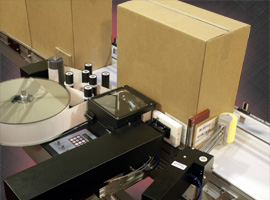
A label printer applicator is a basic robot that can automatically print and apply pressure-sensitive labels to various products. Some types of labeling include shipping labeling, content labeling, graphic images, and labeling to comply with specific standards such as those of GS1 and Universal Product Code U.P.C. A pressure-sensitive label consists of a label substrate and adhesive.

Edge banding or edgebanding is the name of both a process and an associated narrow strip of material used to create durable and aesthetically pleasing trim edges during finish carpentry.

Roll slitting is a shearing operation that cuts a large roll of material into narrower rolls. There are two types of slitting: log slitting and rewind slitting. In log slitting the roll of material is treated as a whole and one or more slices are taken from it without an unrolling/re-reeling process. In rewind slitting the web is unwound and run through the machine, passing through knives or lasers, before being rewound on one or more shafts to form narrower rolls. The multiple narrower strips of material may be known as mults or pancakes if their diameter is much more than their width. For rewind slitting the machine used is called a slitter rewinder, a slitter or a slitting machine – these names are used interchangeably for the same machines. For particularly narrow and thin products, the pancakes become unstable, and then the rewind may be onto a bobbin-wound reel: the rewind bobbins are much wider than the slit width and the web oscillates across the reel as it is rewound. Apart from the stability benefit it is also then possible to put very long lengths,, onto one bobbin.

Asphalt roll roofing or membrane is a roofing material commonly used for buildings that feature a low sloped roof pitch in North America. The material is based on the same materials used in asphalt shingles; an organic felt or fiberglass mat, saturated with asphalt, and faced with granular stone aggregate. The installation process, known as Torch On Roofing, is often used on commercial properties in North America.
References
- ↑ "Lamination Resources Guide" . Retrieved 2009-08-12.